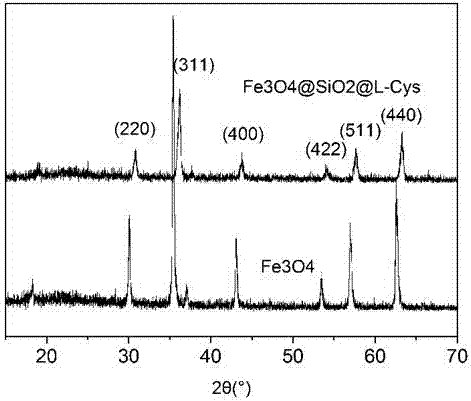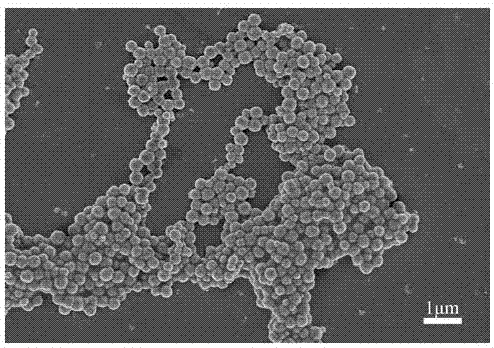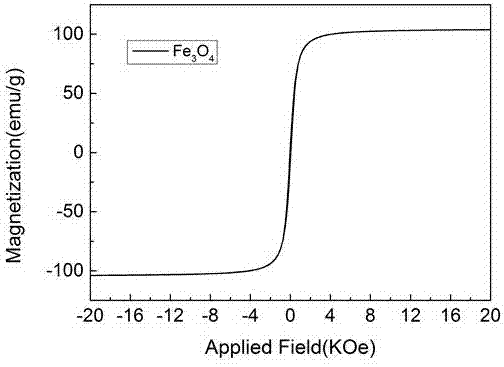Group enhanced type magnetic nanometer water treatment agent and preparation method and application thereof
A water treatment agent, magnetic nano technology, applied in water/sewage treatment, adsorption water/sewage treatment, water/sludge/sewage treatment, etc., can solve low adsorption efficiency, irregular shape, wide particle size distribution, etc. problem, to achieve a stable effect
- Summary
- Abstract
- Description
- Claims
- Application Information
AI Technical Summary
Problems solved by technology
Method used
Image
Examples
Embodiment 1
[0035] (1) Accurately weigh 3 g of ferric chloride hexahydrate and 7.5 g of anhydrous sodium acetate powder, and add 75 ml of ethylene glycol solution, stir vigorously at normal temperature until completely dissolved; then add 0.5 g of polyethylene glycol (Mw = 10000) stirred for 2 hours until the system was uniformly dispersed;
[0036] (2) Pour the solution obtained by stirring in step (1) into a titanium-zirconium alloy high-pressure reactor container and react for 8 hours to obtain a reaction product, and the reaction temperature is 200° C.;
[0037] (3) Magnetically absorb the reaction product obtained in step (2), wash the reaction product 5 times with ethanol and deionized water, and place it in a freeze dryer to dry for 10 hours at a drying temperature of 60°C and a vacuum degree of Less than 1000Pa; get Fe 3 o 4 magnetic nanoparticles;
[0038] (4) Magnetic Fe obtained in step (3) 3 o 4 Add 500ml of ethanol aqueous solution with a volume concentration of 75% to t...
Embodiment 2
[0042] (1) Accurately weigh 3 g of ferric chloride hexahydrate and 9 g of anhydrous sodium acetate powder, add 75 ml of ethylene glycol solution, stir vigorously at normal temperature until completely dissolved; then add 0.5 g of polyethylene glycol (Mw=10000 ) stirred for 2 hours until the system was uniformly dispersed;
[0043] (2) Pour the solution obtained by stirring in step (1) into a titanium-zirconium alloy high-pressure reactor container and react for 7 hours to obtain a reaction product, and the reaction temperature is 200° C.;
[0044] (3) Magnetically absorb the reaction product obtained in step (2), wash the reaction product 5 times with ethanol and deionized water, and then place it in a freeze dryer to dry for 10 hours at a drying temperature of 70°C and a vacuum degree of Less than 1000Pa; get magnetic Fe 3 o 4 nanoparticles;
[0045] (4) Fe obtained in step (3) 3 o 4 Add 500ml of ethanol aqueous solution with a volume concentration of 70% to the magnetic...
Embodiment 3
[0049] (1) Accurately weigh 3 g of ferric chloride hexahydrate and 6 g of anhydrous sodium acetate powder, add 75 ml of ethylene glycol solution, stir vigorously at normal temperature until completely dissolved; then add 0.5 g of polyethylene glycol (Mw=10000 ) stirred for 2 hours until the system was uniformly dispersed;
[0050] (2) Pour the solution obtained by stirring in step (1) into a titanium-zirconium alloy high-pressure reactor container and react for 9 hours to obtain a reaction product, and the reaction temperature is 200° C.;
[0051] (3) Magnetically absorb the reaction product obtained in step (2), wash the reaction product 5 times with ethanol and deionized water, and then place it in a freeze dryer to dry for 10 hours at a drying temperature of 80°C and a vacuum degree of Less than 1000Pa; get magnetic Fe 3 o 4 nanoparticles;
[0052] (4) Fe obtained in step (3) 3 o 4 Add 500ml of ethanol aqueous solution with a volume concentration of 80% to the magnetic...
PUM
 Login to View More
Login to View More Abstract
Description
Claims
Application Information
 Login to View More
Login to View More - R&D
- Intellectual Property
- Life Sciences
- Materials
- Tech Scout
- Unparalleled Data Quality
- Higher Quality Content
- 60% Fewer Hallucinations
Browse by: Latest US Patents, China's latest patents, Technical Efficacy Thesaurus, Application Domain, Technology Topic, Popular Technical Reports.
© 2025 PatSnap. All rights reserved.Legal|Privacy policy|Modern Slavery Act Transparency Statement|Sitemap|About US| Contact US: help@patsnap.com



